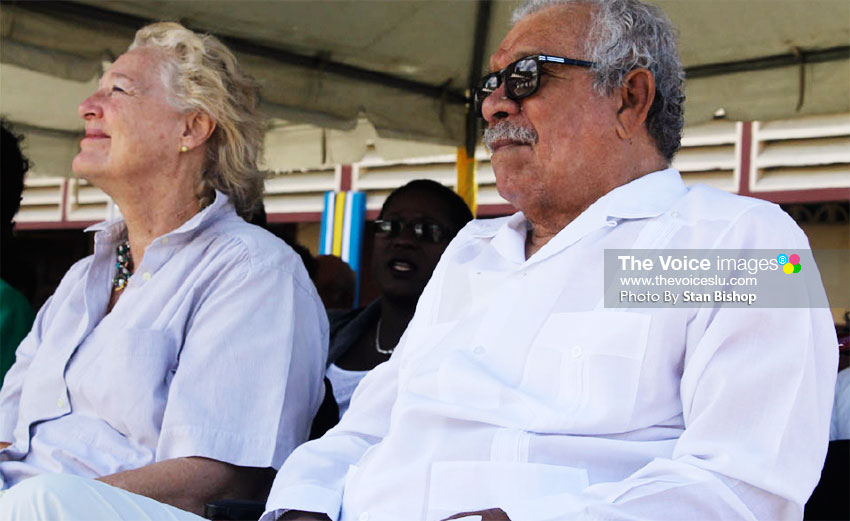
(Dedicated to Ms. Sigrid Walcott)
MANY people may not have known that this writer, growing up in the City of Castries, was an adventurous lad, wanting to know and see all things, primarily God’s creation, the natural world with all its splendour which mortal man in all his attempt cannot comprehend, its mind-boggling. However, the Good Lord has left us with abilities to reach the highest potentials of our human potentials, and peradventure these potentials are well-managed, we mortals will also create wonders to behold, that we would ask, how did they do it?
Endowed by Him who has created us in His Image, after His Likeness, with such abilities, though some of us have not given thought to this awesome power of the brain, on the other hand, some have explored and have reached incredible heights of success in their chosen field of endeavour.
It is against this backdrop that I want to single out one individual who has made maximum use of this human potential to universal acceptance, as we begin to highlight Nobel Laureate Festival and to pay homage to this individual who had been the soul of Saint Lucia’s culture. It was our own Sir Arthur Lewis, another Nobel Laureate, who stated that, “A society without the arts is a cultural desert”. Sir Arthur Lewis was fully aware of the importance of the arts in society and by his observation he has placed Sir Derek Alton Walcott as the one to lead the way.
Sir Derek is colourful and linear, as he once wrote, “I’m just a red nigger who love the sea, I had a sound colonial education, I have Dutch, nigger, and English in me, And either I’m nobody, or I’m a nation. How much colourful can he be?” That sums it up. Sir Derek embraces all colours and languages, thus when he had won the Nobel Prize in Literature in 1992 the entire globe celebrated him on his remarkable achievement with which the Swedish Academy honoured him.
With two postage stamps of his image, this been the first in history. Sir Derek was pleased to have this honour, but more so to celebrate his success with his soulmate for many years, affectionately known as Sigrid, who was everything to him right up to the time of his demise in March 2017.

My knowledge of Sir Derek began quite early as a school boy going to the Castries Town Hall where I had secured a seat on top of the overlap of the hall’s window to watch Sir Derek’s legendary play, “ Ti Jean and his Brothers”, which was mindboggling to me as a lad. I thought to myself how incredible was he to have produced something so amazing, but then I remembered the Creator who had made it possible for Sir Derek, who quite early in his life had discovered this innate potential coming from a background of literary and artistic parents. It was a home that was filled with imagination and creativity which he and his twin brother, Roderick Walcott, tapped into and would not look back. European plays were dramatised in the home and Roddy, as he was known, would act direct on his locally-made paper movie screen.
The brothers were equally gifted, but it was the stars who had fallen in love with Sir Derek, so we can say that Roderick was not in that league as his
Brother, Derek, in that regard, while at the same time he was an accomplished creative artist and is believed to be Sir Derek’s inspiration.
In this one dramatic play, “Ti Jean and his Brothers”, I saw a legend in the making, a name to be etched in the annals of history. From that Moment, I would keep my ears to the ground, so to speak, for a work was in progress. He had arrived before he arrived, and that was why I kept abreast with his progress, for in Ti Jean, was hope.
Sir Derek kept on believing and working, crossing all T’s and dotting all I’s. Ti Jean and his Brothers was the talk of the town and Derek, a colossus, stands head and shoulder with those giants who have gone before him. He was professional and critical about his work with his many amendments, a sign of genius that gave birth to his several epic plays and poems, including “Ti’ Jean and his Brothers”, “A City’s Death by Fire”, “Omeros”, “Starry Starry Night”, “The Joker of Seville”, “Dream on Monkey Mountain”, and the list goes on. To have had to achieve such acclaim for his work came with much sacrifice, determination and the will to succeed. His works are now in the same league as Picasso’s “Guernica”, Veronese’s “Marriage Feast at Cana”, Da Vinci’s “Mona Lisa”, Shakespeare’s “Romeo and Juliet”, John Milton’s “Paradise Lost”, Mozart’s “The Marriage of Figaro”, Beethoven’s “Nine Symphonies in D minor”, Michelangelo’s “Pieta”, Sir Arthur Lewis’s “Agony of the Eight”, Elvis Presley’s “That’s All Right Mama”, John Bunyan’s “Pilgrim’s Progress”, Charles Darwin’s “Origin of Species” — all epic works that have found that have their places in the annals of history.
It was almost like divine intervention, seeing him so early in my life how he had opened up to me and closing him with a portrait of himself titled “Casually Derek”, a life-size in line with acrylic on canvas, commissioned by Sigrid Walcott to be unveiled soon at Derek’s Museum.
Phenomenally, the boy from Chaussee Road came, saw and conquered. His memory remains with us as the hope and dream of the slave. Of all the legacies which Sir Derek has secured, there is something that was special to him, the land of his birth as he would say, “Moic’est gens St. Lucie. C’est la moisorti; is there that I born.”











![Simón Bolívar - Liberator of the Americas [Photo credit: Venezuelan Embassy]](https://thevoiceslu.com/wp-content/uploads/2025/12/Simon-Bolivar-feat-2-380x250.jpg)
